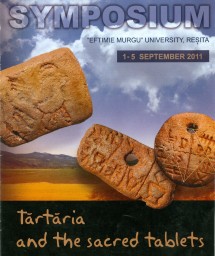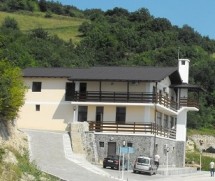International Symposium on Tărtăria and the Sacred Tablets
 “Eftimie Murgu” University, Reşiţa, Romania, collaborated with the Institute of Archaeomythology, Euro Innovanet SRL, Italy, and the Romanian Academy, Iaşi, to sponsor an international symposium to celebrate fifty years since Nicolae Vlassa’s earliest excavations at the Neolithic Transylvanian site of Tărtăria.
“Eftimie Murgu” University, Reşiţa, Romania, collaborated with the Institute of Archaeomythology, Euro Innovanet SRL, Italy, and the Romanian Academy, Iaşi, to sponsor an international symposium to celebrate fifty years since Nicolae Vlassa’s earliest excavations at the Neolithic Transylvanian site of Tărtăria.
In 1961, Nicolae Vlassa discovered the cult pit where the famous Tărtăria tablets were found. The symposium was organized around two main themes: The evolution of the Vinča culture, and the significance of the Tărtăria tablets for the “Danube Script.”
 The symposium took place September 1-5, 2011 in the guesthouse of “Eftimie Murgu” University in the village of Coronini (Pescari) on the bank of the Danube at the entrance to the Iron Gates.
The symposium took place September 1-5, 2011 in the guesthouse of “Eftimie Murgu” University in the village of Coronini (Pescari) on the bank of the Danube at the entrance to the Iron Gates.
At this location, the Danube River defines the boundary between Romania and Serbia. This region is rich in Mesolithic and Neolithic sites. Not far from the place of the symposium, on the Serbian side of the Danube within the Iron Gates gorge, is the important archaeological site of Lepenski Vir.
Papers presented at the symposium:
Beatrice Ciuta, “Reconstruction attempts of vegetation during Vinča culture. Habitat of prehistoric settlements from Limba-Oarda de Jos (Albe County).”
Marius Ciută, “Two Vinča graves at the Limba site.”
Laura Coltofean, “Documents regarding Zsófia Torma’s activity.”
Miriam Robbins Dexter, “Further thoughts on the V and the M in the Danube Script.”
Harald Haarmann and Joan Marler, “Milady of Tartaria and the prominence of women in Old European ritual life.”
Gheorghe Lazarovici, Cult significations of the signs on the Tărtăria tablets.
Marco Merlini, “The Danube Script: Unique or widespread signs?”
Carsten Mischka, “Prospektion und der Grabung in Iclod im Vergleich zu dem, was ich aus der Literatur zusammenstellen kann.”
Johannes Müller, “Okoliste and the work of the Kieler Bosnien-Projects (Parallel to Vinča A-D).”
Adrian Poruciuc, “Signs of the Danube Script (DS) interpretable as ideograms.”
Adriana Radu and Flavius Bozu, “Signs and symbols at Zorlenţu Mare.”
Angeleski Sote, “Vinčian aspects concerning the spiritual life of Macedonia.”
Nicolae Ursulescu, “Information From the English Archeologist Francis John Haverfield Concerning the Turdaş Objects with Symbolic Signs.”
